Main story: For decades, Gilroy coach shaped young people’s lives
A family man, Jim Fahey survived a fire, plane crash to have an incredible life
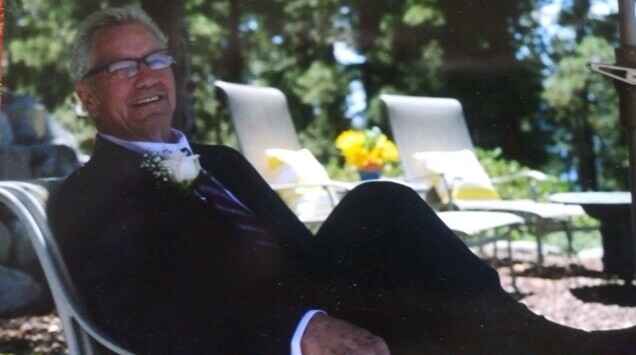
Photo courtesy Fahey family — Jim Fahey relaxes at his son’s wedding.
By Marty Cheek
Jim Fahey had an incredible life, that’s for sure.
 Well-loved as a physical education teacher and wrestling coach at South Valley Middle School and as a football coach at Gilroy High School, Fahey died June 17 in his home in Pahrump, Nevada at the age of 83 after a three-year battle with cancer, Parkinson’s, and emphysema.
Well-loved as a physical education teacher and wrestling coach at South Valley Middle School and as a football coach at Gilroy High School, Fahey died June 17 in his home in Pahrump, Nevada at the age of 83 after a three-year battle with cancer, Parkinson’s, and emphysema.
To honor his impact on so many young people during his life, several of his friends have launched an initiative to raise money to create a memorial scholarship in his name for Gilroy High School athletes.
The project was started by Ron Leonti, who first met Fahey when they were in the third grade and in the Cub Scouts. The young Fahey climbed into a car with the rest of the boys. Squeezing next to the young Leonti, he started pounding him on his thigh. “I asked, ‘What are you doing?’” Leonti recalled “’I’m giving you a charley horse,’” he replied. “I don’t want a charley horse. Stop it!” Leonti warned him.
After that first encounter, the two remained the best of friends for life.
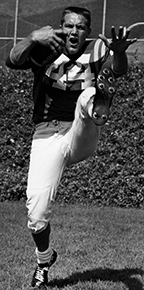 Fahey was born Sept. 5, 1936. One day, his father tied his toddler son to a chair and set the house on fire. Somehow, he was rescued from a fiery death. The child became a ward of the state of California and was sent to St. Vincent Home for Boys in San Rafael. It was a rough time in his life. He was sometimes beaten or emotionally neglected. Seven years later, he moved to the I.O.O.F. orphanage in Gilroy where he stayed until he turned 18. During those years, he learned resiliency. With a muscular physique, he proved himself an outstanding athlete, excelling at football, wrestling, and boxing.
Fahey was born Sept. 5, 1936. One day, his father tied his toddler son to a chair and set the house on fire. Somehow, he was rescued from a fiery death. The child became a ward of the state of California and was sent to St. Vincent Home for Boys in San Rafael. It was a rough time in his life. He was sometimes beaten or emotionally neglected. Seven years later, he moved to the I.O.O.F. orphanage in Gilroy where he stayed until he turned 18. During those years, he learned resiliency. With a muscular physique, he proved himself an outstanding athlete, excelling at football, wrestling, and boxing.
After graduating from Gilroy High School in 1956, he attended Hartnell Junior College, then served in the U.S. Army stationed in Alaska. He was encouraged to go into professional boxing. He was also offered a full football scholarship to Cal Poly in San Luis Obispo. As his friend, Leonti encouraged him to go to college. Fahey took the scholarship and joined the Mustangs. As a half back, his jersey number was 44.
For a game against Bowling Green State University Oct. 30, 1960, the Cal Poly team flew to Toledo, Ohio, in an Arctic-Pacific chartered plane, a twin-engine Curtis C-46. The Mustangs lost 50 to 6. On the trip back home, the fog at the Toledo airport was so thick the airplane on the tarmac was nearly invisible until the players almost bumped into it. Fahey found a seat in the back.
The plane climbed 100 feet over the runway when the left engine failed, quickly followed by the right one. Of the 48 people on board, 22 died in the crash, including 16 football players, the team manager and an alumni booster. Of the 26 survivors, 24 had to be hospitalized. Investigators determined the plane was 2,000 pounds overweight. With zero visibility, it should never have taken off.
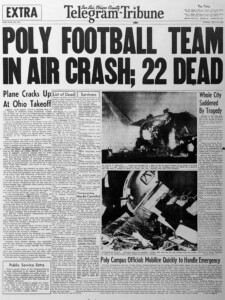 Fahey suffered a broken neck and internal injuries. Despite his condition, he unfastened his seatbelt and he and teammate Don Adams managed to drag out as many people as they could as the aircraft was consumed by fire. The two pilots and most of the passengers in the front and middle of the plane were killed.
Fahey suffered a broken neck and internal injuries. Despite his condition, he unfastened his seatbelt and he and teammate Don Adams managed to drag out as many people as they could as the aircraft was consumed by fire. The two pilots and most of the passengers in the front and middle of the plane were killed.
The psychological trauma of the horrific crash would haunt Fahey for the rest of his life, said Carol Peters, his second wife. She would accompany him to annual reunions where the team members who survived came together..
“He would have nightmares about the crash. When he was sleeping, he’d wake up screaming, sweating,” she said. “He said that everyone was on fire. When you play on a team, you’re bonded with the people on the team. He said even with his broken neck, he was trying to save people by pulling them out.”
While in college, Fahey was recruited by the San Francisco 49ers and Chicago Bears. Instead of playing professional football, he decided to choose a teaching career in Gilroy. He taught P.E. and coached football and wrestling, following his true passion of mentoring and helping young people. In his 30-year tenure as a wrestling coach at Brownell and South Valley his wrestlers never lost a dual meet and remained undefeated. Coach Fahey was an integral part of Gilroy’s wrestling history and dynasty. He was inducted into the Gilroy High School and Cal Poly SLO halls of fame for football. He is often called the “Godfather of Gilroy Wrestling.”
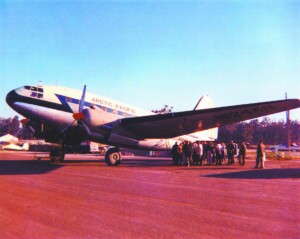 Fahey’s first wife, Marilyn, died of cancer. Peters, a widow with two children, married him to join his three kids into a large household. He was a man filled with fierce passion, Peters recalls.
Fahey’s first wife, Marilyn, died of cancer. Peters, a widow with two children, married him to join his three kids into a large household. He was a man filled with fierce passion, Peters recalls.
“The way he grew up, the way he had to fight for everything, I think fighting was at his core because as a child, fending for himself and fighting his way through the orphanages, fighting to survive in a lot of ways, that energy was directed,” she said.
If he hadn’t been for the plane crash, he most likely would have gone on to a career as a professional football player, she believes. That would have been a different life path where he wouldn’t have had such an influence on all his students and other Gilroy residents.
“He motivated them and changed them. The accident absolutely altered his life, and he was able to help all these individuals,” she said. “He wouldn’t have gone into teaching, I’m sure.”
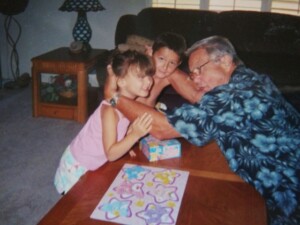 Jim met his third wife, Suzanne Fahey, at South Valley Community Church in Gilroy. They were married 10 months later on Jan. 17, 1987. Suzanne recalls many happy memories during their 34-year marriage. After the couple retired, they moved to Pahrump in 2000. Their new home was in a golf course community where Jim played his rounds of the game three days a week.
Jim met his third wife, Suzanne Fahey, at South Valley Community Church in Gilroy. They were married 10 months later on Jan. 17, 1987. Suzanne recalls many happy memories during their 34-year marriage. After the couple retired, they moved to Pahrump in 2000. Their new home was in a golf course community where Jim played his rounds of the game three days a week.
“He was my knight in shining armor,” she said. “I had been widowed and divorced and I was going through a lot of turmoil in my life and the Lord just dropped him in my lap. Jim was an outstanding human being. He loved children, and he chose his (teaching/coaching) profession because he was an orphan.”
Jim’s son, James Fahey, recalls his father’s impact on Gilroy’s youths. On occasions the coach would see students with athletic potential, take them home after school and meet the parents and convince them that the kids should be playing sports. He would even go out of his way to drive his students to wrestling or football practice.
“He pushed kids as hard as he could, but with love,” James said. “He saw the potential in them even if they didn’t see it themselves at that young and impressionable age.”
Students looked back on him in fondness because he never cast judgment based on race or their monetary stature, he said.
 “He was just respected by so many people,” he said. “I can’t tell you how many times in my life that total strangers came up to me and told me how impactful he was in their lives and how he changed their lives and they wouldn’t be where they were today if it wasn’t for him. I must have heard that from 150 people.”
“He was just respected by so many people,” he said. “I can’t tell you how many times in my life that total strangers came up to me and told me how impactful he was in their lives and how he changed their lives and they wouldn’t be where they were today if it wasn’t for him. I must have heard that from 150 people.”
When Fahey and Suzanne moved to Pahrump, he kept up his rigorous life of sporting activities, even entering the Senior Olympics in Nevada and winning several medals. In September 2013, he carded his first career hole-in-one — at the age of 77 — hitting the ball over trees and water on the 220-yard 11th hole at Lake View Executive Golf Course in Pahrump. He made a second hole-in-one at the age of 79.
 After Fahey’s death in June, James put a post about his passing on Facebook. A “huge following” of local people responded with fond memories of the beloved coach. Because of the pandemic, Fahey could not receive the memorial service he deserved, so the plan to create a scholarship in his name for Gilroy High School students can serve to continue his mission of helping youths, his son said.
After Fahey’s death in June, James put a post about his passing on Facebook. A “huge following” of local people responded with fond memories of the beloved coach. Because of the pandemic, Fahey could not receive the memorial service he deserved, so the plan to create a scholarship in his name for Gilroy High School students can serve to continue his mission of helping youths, his son said.
“A couple of people who are athletic directors at Christopher High that I went to school with tried to get a memorial service in his name. That kind of fell through the cracks,” he said. “So I think a scholarship is amazing.”
